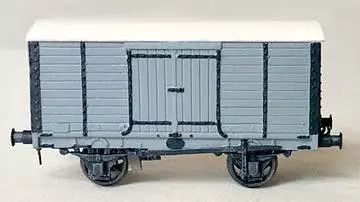The development history of containers
Date:2023-11-03
Containers are one of the great miracles created by mankind in history and are widely used in logistics and transportation systems such as ships, ports, railways, and highways.
- The budding period (1830-1856)
In 1801, the British Dr. James Anderson first proposed the idea of container transportation.
In 1830, a container for coal first appeared on the British railways, and large containers were also used to transport groceries on the railways.
By the second half of the 19th century, a railway pallet with a movable frame appeared in Lancashire, England, for transporting cotton gauze. This can be regarded as the prototype of the container.
In 1853, U.S. railroads also adopted container shipping. This is the earliest prototype of container transportation in the world.
In 1880, the United States officially trial-produced the first container ship for inland waterways. The official use of containers was in the early 20th century.
It was not until the early 20th century that new modes of transportation were promoted. Due to the development of the world economy, land transportation volume in Western countries has increased rapidly, and railway transportation has developed rapidly. At this time, British Railways tried to pack furniture into wooden containers and transport it on railway flat cars. After arriving at the station, a crane was used to transfer the boxes to horse-drawn carriages, which then transported the goods to their destination.
In the early days of container transportation, the structures and specifications of containers were different, which affected the international circulation of containers. There was an urgent need to formulate international standards for containers to facilitate their development.
In 1933, the International Container Association was established in Paris, responsible for formulating unified container standards. This is a private container transportation organization. It aims to coordinate the cooperative relationship between all parties involved in the container and conducts “container owner” registration business.
- The pioneering period (1956-1966)
In 1955, American Malcom McLean first put forward the view that container transportation must realize sea-land combined transportation. In order to facilitate sea-land combined transportation, he advocated that land transportation and sea transportation be controlled and managed by one company.
In 1953, McLean proposed the idea of building a terminal freight terminal, where trucks would drive up ramps to specially designed ships and unload trailers. Ships can carry trailers to ports such as New York. After the ship arrives at the port, the trailers are picked up by other truck heads. In this way, “sea and land combined transportation” can be achieved.
In April 1956, the American Transatlantic Shipping Company used a modified T-2 oil tanker “Maxton” to load 58 large containers on the deck to trial the New York to Houston route. The three-month trial operation achieved great economic results and demonstrated the great advantages of container transportation.
In October 1957, the company converted six C-2 general cargo ships into full container ships with boxes. The ship is equipped with a container loading and unloading bridge, has a load capacity of 90,000 tons, and carries 226 35-foot containers with a total container weight of 25 tons. It sails from New York to Houston. This marked the official start of maritime container transportation.
- Growth and expansion period (1966-late 1980s)
In April 1966, Sea-Land Transportation Company (formerly American Transatlantic Shipping Company) opened a container transportation route from New York to Europe with a modified full-container ship.
In September 1967, Matoson Shipping Company launched the “Hawaiian Colonist” full container ship on the route from Japan to the Pacific coast of North America. A year later, there were six shipping companies in Japan carrying out container transportation between Japan and California. Immediately afterwards, shipping companies from Japan and European countries successively launched container transportation in Japan, Europe, the United States, Australia and other regions. With the development of maritime container transportation, countries around the world are generally building dedicated container terminals.
The 1970s and 1980s were an era of computer software development. In this era, the goal of “door-to-door” transportation was directed toward the systematic direction of international multimodal transportation, and systematic transportation and intermodal transportation systems began to be built. This also prepares for the arrival of the mature period of container transportation.
- Modern Maturity Period (late 1980s to present)
At present, container transportation has spread all over the world, and the containerization level of general cargo transportation among developed countries has reached more than 80%.
During this period, the connection and matching between the three links of ship transport capacity, port throughput capacity and inland collection and distribution capacity are becoming increasingly perfect. The hardware and software related to container transportation are becoming more and more perfect. All relevant links are closely connected and supporting construction; container transportation Multimodal transport has developed rapidly. Container transportation between developed countries has basically realized multimodal transport. The growth momentum of multimodal transport in developing countries is also very impressive.
Next: Namibia Tender – Luderitz Port Expansion Phase 3
RELATED
- Types of pneumatic rubber fenders you should know
- 800H cell rubber fenders fly to Saudi Arabia
- Difference between Gross Tonnage, Net Tonnage, and Deadweight Tonnage
- Portugal Tender – Northern Fishing Port Maintenance Dredging
- ID750 dredging hoses and bow floaters for TSHD were delivered
- New shipment of ID500 discharge rubber hoses for dredging
- Effective Ship Anchoring: Key Steps for Stability and Safety
- Sweden Tender – Quay front reinforcement & rubber fenders replacement at Norrköping harbor



